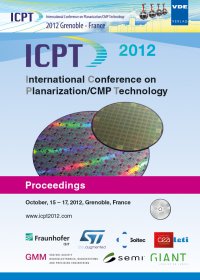Oxide Rate and Selectivity as a Function of Pad Chemistry,
Konferenz: ICPT 2012 - International Conference on Planarization / CMP Technology
15.10.2012-17.10.2012 in Grenoble, France
Tagungsband: ICPT 2012
Seiten: 6Sprache: EnglischTyp: PDF
Persönliche VDE-Mitglieder erhalten auf diesen Artikel 10% Rabatt
Autoren:
Renteln, Peter; Hsu, Oscar (InnoPad Company, Wilmington, MA, USA)
Inhalt:
Traditionally, the role of the polishing pad in CMP performance has been considered to be primarily related to the mechanical aspects of the pad, referring either to the bulk physical properties of the pad such as Hardness, Compressibility and dynamic properties such as frequency- and temperaturedependent Modulus and tan δ, or, surface morphology such as roughness, groove or hole pattern, or the effect of different conditioning processes. Chemical interactions between wafer and slurry are more typically studied, whereas the chemical role of the CMP polishing pad is not often considered. However, we have found that pad chemistry may have a significant impact on pad performance, which could potentially be exploited in future pad design. Much attention is focused on the interaction of the Ceria slurry and the wafer. The Ζ potential of the Ceria abrasive particles is of primary consideration in the optimization of such slurries. Typically, for STI, an additive is used in conjunction with the Ceria to improve selectivity. The additive adjusts the Ζ potential of the Ceria to be repulsive to the nitride. In the process, the optimal value for oxide removal is also compromised, but the net result is significantly higher selectivity at the expense of a lower oxide rate. This design focuses on the net attraction or repulsion between slurry particles and the film to be removed. Apparently, the model is made more complete by including the interaction between slurry particles and the pad surface. In this paper, evidence is presented of the impact of the chemical state of the pad on the behavior of Ceria slurries on TEOS oxide and LPCVD nitride removal. Compared to a control pad, a polar additive is added to the pad before solidification, and the impact of the additive is a decrease of both the oxide and nitride removal rates. The relative decrease in the two removal rates is similar, resulting in a Selectivity as defined by the ratio of blanket wafer rates that is unchanged.


